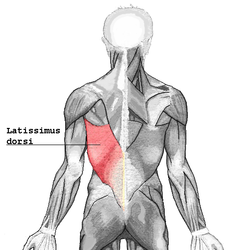Latissimus
| Latissimus Dorsi | |
|---|---|

Latissimus dorsi
|
|

Muscles connecting the upper extremity to the vertebral column.
|
|
| Details | |
| Origin | Spinous processes of vertebrae T7-T12, thoracolumbar fascia, iliac crest, inferior 3 or 4 ribs and inferior angle of scapula |
| Insertion | Floor of intertubercular groove of the humerus |
| Artery | Thoracodorsal branch of the subscapular artery |
| Nerve | Thoracodorsal nerve(C6,C7,C8) |
| Actions | Adducts, extends and internally rotates the arm when the insertion is moved towards the origin. When observing the muscle action of the origin towards the insertion, the lats are a very powerful rotator of the trunk. |
| Antagonist | Deltoid and trapezius muscle |
| Identifiers | |
| Latin | Musculus latissimus dorsi |
| Dorlands /Elsevier |
m_22/12549548 |
| TA | A04.3.01.006 |
| FMA | 13357 |
|
Anatomical terms of muscle
[]
|
|
The latissimus dorsi (/ˌləˈtɪsᵻməs ˈdɔːrsaɪ/) a large, flat muscle on the back that stretches to the sides, behind the arm, and is partly covered by the trapezius on the back near the midline. The word latissimus dorsi (plural: latissimi dorsi) comes from Latin and means "broadest [muscle] of the back", from "latissimus" (Latin: broadest)' and "dorsum" (Latin: back). The Latissimi dorsi are commonly known as "lats", especially among bodybuilders.
The latissimus dorsi is responsible for extension, adduction, transverse extension also known as horizontal abduction, flexion from an extended position, and (medial) internal rotation of the shoulder joint. It also has a synergistic role in extension and lateral flexion of the lumbar spine.
Due to bypassing the scapulothoracic joints and attaching directly to the spine, the actions the latissimi dorsi have on moving the arms can also influence the movement of the scapulae, such as their downward rotation during a pull up.
...
Wikipedia
